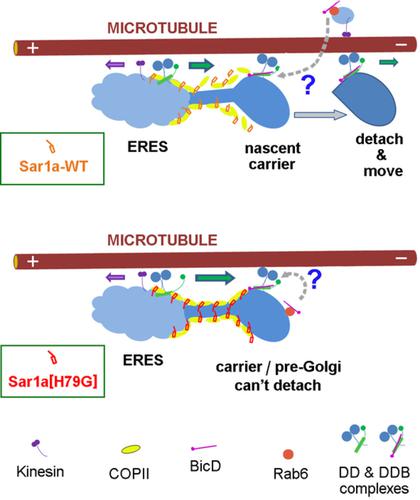Our official English website, www.x-mol.net, welcomes your feedback! (Note: you will need to create a separate account there.)
Positioning of endoplasmic reticulum exit sites around the Golgi depends on BicaudalD2 and Rab6 activity
Traffic ( IF 4.5 ) Pub Date : 2020-12-12 , DOI: 10.1111/tra.12774 Olga Shomron 1 , Koret Hirschberg 1 , Anton Burakov 2 , Rimma Kamentseva 3 , Elena Kornilova 3 , Elena Nadezhdina 4 , Ilya Brodsky 2
Traffic ( IF 4.5 ) Pub Date : 2020-12-12 , DOI: 10.1111/tra.12774 Olga Shomron 1 , Koret Hirschberg 1 , Anton Burakov 2 , Rimma Kamentseva 3 , Elena Kornilova 3 , Elena Nadezhdina 4 , Ilya Brodsky 2
Affiliation

|
The endoplasmic reticulum (ER) is involved in biogenesis, modification and transport of secreted and membrane proteins. The ER membranes are spread throughout the cell cytoplasm as well as the export domains known as ER exit sites (ERES). A subpopulation of ERES is centrally localized proximal to the Golgi apparatus. The significance of this subpopulation on ER‐to‐Golgi transport remains unclear. Transport carriers (TCs) form at the ERES via a COPII‐dependent mechanism and move to Golgi on microtubule (MT) tracks. It was shown previously that ERES are distributed along MTs and undergo chaotic short‐range movements and sporadic rapid long‐range movements. The long‐range movements of ERES are impaired by either depolymerization of MTs or inhibition of dynein, suggesting that ERES central concentration is mediated by dynein activity. We demonstrate that the processive movements of ERES are frequently coupled with the TC departure. Using the Sar1a[H79G]‐induced ERES clustering at the perinuclear region, we identified BicaudalD2 (BicD2) and Rab6 as components of the dynein adaptor complex which drives perinuclear ERES concentration at the cell center. BicD2 partially colocalized with ERES and with TC. Peri‐Golgi ERES localization was significantly affected by inhibition of BicD2 function with its N‐terminal fragment or inhibition of Rab6 function with its dominant‐negative mutant. Golgi accumulation of secretory protein was delayed by inhibition of Rab6 and BicD2. Thus, we conclude that a BicD2/Rab6 dynein adaptor is required for maintenance of Golgi‐associated ERES. We propose that Golgi‐associated ERES may enhance the efficiency of the ER‐to‐Golgi transport.
中文翻译:

高尔基体周围的内质网出口位点的位置取决于BicaudalD2和Rab6的活性
内质网(ER)参与分泌蛋白和膜蛋白的生物发生,修饰和运输。ER膜遍布整个细胞质以及称为ER出口位点(ERES)的输出域。ERES的亚群集中定位在高尔基体近端。该亚群对内质网向高尔基体运输的重要性尚不清楚。转运载体(TC)通过依赖COPII的机制在ERES形成,并通过微管(MT)轨道移动到高尔基体。先前已证明,ERES沿MT分布,并经历混沌的短距离运动和零星的快速长距离运动。MTs的解聚或抑制动力蛋白会削弱ERES的远距离运动,表明ERES的中枢浓度是由动力蛋白的活性介导的。我们证明了ERES的过程性运动经常与TC离开有关。使用Sar1a [H79G]诱导的ERES聚集在核周区域,我们鉴定了BicaudalD2(BicD2)和Rab6是达因素衔接复合物的成分,该复合物可驱动细胞中心ERES浓度。BicD2与ERES和TC部分共定位。Peri-Golgi ERES的定位受到其N端片段对BicD2功能的抑制或其显性负突变体对Rab6功能的抑制的影响。抑制Rab6和BicD2可以延迟分泌高尔基蛋白的积累。因此,我们得出结论,维持高尔基体相关的ERES需要使用BicD2 / Rab6动力蛋白适配器。我们建议,与高尔基体相关的ERES可以提高ER到高尔基体运输的效率。
更新日期:2021-02-19
中文翻译:

高尔基体周围的内质网出口位点的位置取决于BicaudalD2和Rab6的活性
内质网(ER)参与分泌蛋白和膜蛋白的生物发生,修饰和运输。ER膜遍布整个细胞质以及称为ER出口位点(ERES)的输出域。ERES的亚群集中定位在高尔基体近端。该亚群对内质网向高尔基体运输的重要性尚不清楚。转运载体(TC)通过依赖COPII的机制在ERES形成,并通过微管(MT)轨道移动到高尔基体。先前已证明,ERES沿MT分布,并经历混沌的短距离运动和零星的快速长距离运动。MTs的解聚或抑制动力蛋白会削弱ERES的远距离运动,表明ERES的中枢浓度是由动力蛋白的活性介导的。我们证明了ERES的过程性运动经常与TC离开有关。使用Sar1a [H79G]诱导的ERES聚集在核周区域,我们鉴定了BicaudalD2(BicD2)和Rab6是达因素衔接复合物的成分,该复合物可驱动细胞中心ERES浓度。BicD2与ERES和TC部分共定位。Peri-Golgi ERES的定位受到其N端片段对BicD2功能的抑制或其显性负突变体对Rab6功能的抑制的影响。抑制Rab6和BicD2可以延迟分泌高尔基蛋白的积累。因此,我们得出结论,维持高尔基体相关的ERES需要使用BicD2 / Rab6动力蛋白适配器。我们建议,与高尔基体相关的ERES可以提高ER到高尔基体运输的效率。


























 京公网安备 11010802027423号
京公网安备 11010802027423号